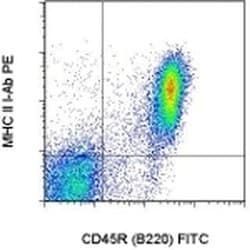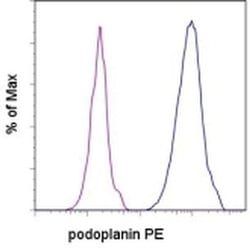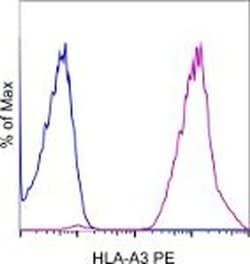MHC Class II I-Ab Monoclonal Antibody (AF6-120.1), PE, eBioscience™, Invitrogen™
Manufacturer: Fischer Scientific
Select a Size
| Pack Size | SKU | Availability | Price |
|---|---|---|---|
| Each of 1 | 50-112-2323-Each-of-1 | In Stock | ₹ 22,072.00 |
50-112-2323 - Each of 1
In Stock
Quantity
1
Base Price: ₹ 22,072.00
GST (18%): ₹ 3,972.96
Total Price: ₹ 26,044.96
Antigen
MHC Class II I-Ab
Classification
Monoclonal
Concentration
0.2 mg/mL
Formulation
PBS with 0.09% sodium azide; pH 7.2
Gene Accession No.
P01921, P06342, P06343, P06344, P06345, P06346, P14483
Gene Symbols
H2-Ab1
Purification Method
Affinity chromatography
Regulatory Status
RUO
Gene ID (Entrez)
14961
Content And Storage
4° C, store in dark, DO NOT FREEZE!
Form
Liquid
Applications
Flow Cytometry
Clone
AF6-120.1
Conjugate
PE
Gene
H2-Ab1
Gene Alias
Abeta; AI845868; CELIAC1; DADB-249P12.2; H-2 class II histocompatibility antigen, A beta chain; H-2Ab; H2-Ab; H2-Ab1; H2Eb; H-2Eb; H2-iabeta; histocompatibility 2, class II antigen A, beta 1; HLA-DQB; Ia2; Ia-2; Ia4; Ia-4; IAb; I-Abeta; IDDM1; major histocompatibility complex class II beta chain; MGC163794; MGC163796; MHC class II antigen A beta; MHC class II H2-IA-beta-psi; response to metastatic cancers 1; Rmcs1
Host Species
Mouse
Quantity
100 μg
Primary or Secondary
Primary
Target Species
Mouse
Product Type
Antibody
Isotype
IgG2a κ
Description
- Description: This AF6-120.1 monoclonal antibody reacts with the mouse MHC Class II I-Ab alloantigen of H-2b bearing mouse strains, including C57Bl/6 and 129
- This cell surface molecule is involved in antigen presentation to T cells expressing CD3/TCR and CD4
- The AF6-120.1 antibody crossreacts with H-2k and H-2u haplotypes
- However, reactivity to other haplotypes (i.e., d, f, g7, p, q, r, and s) has not been observed
- Applications Reported: This AF6-120.1 antibody has been reported for use in flow cytometric analysis
- Applications Tested: This AF6-120.1 antibody has been tested by flow cytometric analysis of mouse splenocytes
- This can be used at less than or equal to 0.25 μg per test
- A test is defined as the amount (μg) of antibody that will stain a cell sample in a final volume of 100 μL
- Cell number should be determined empirically but can range from 10^5 to 10^8 cells/test
- It is recommended that the antibody be carefully titrated for optimal performance in the assay of interest
- Excitation: 488-561 nm; Emission: 578 nm; Laser: Blue Laser, Green Laser, Yellow-Green Laser
- Filtration: 0.2 μm post-manufacturing filtered
- I-Ab (H2-Ab1, histocompatibility 2, class II antigen A, beta 1) is an MHC class II heterodimer molecule of non-covalently associated alpha (31-34 kDa) and beta (26-29 kDa) chains
- Major histocompatibility complex class II antigen presentation requires the participation of lysosomal proteases in two convergent processes
- First, the antigens endocytosed by the antigen presenting cells must be broken down into antigenic peptides
- Second, class II molecules are synthesized with their peptide-binding site blocked by invariant chain (Ii), and they aquire the capacity to bind antigens only after Ii has been degraded in the compartments where peptides reside
- MHC class II molecules present exogenously derived antigen to CD4+ T lymphocytes, which are usually T helper cells
- CD4 interacts with non-polymorphic residues of MHC class II
- H2-Ab1 heterodimer chains alpha (DQA) and beta (DQB) are both anchored in the membrane
- H2-Ab1 plays a central role in the immune system by presenting peptides derived from extracellular proteins
- Class II molecules are expressed in antigen presenting cells (APC: B lymphocytes, dendritic cells, macrophages)
- The beta chain contains 6 exons
- Exon one encodes the leader peptide, exons 2 and 3 encode the two extracellular domains, exon 4 encodes the transmembrane domain and exon 5 encodes the cytoplasmic tail
- Within the DQ molecule both the alpha chain and the beta chain contain the polymorphisms specifying the peptide binding specificities, resulting in up to 4 different molecules
- Typing for polymorphisms is routinely done for bone marrow transplantation.



